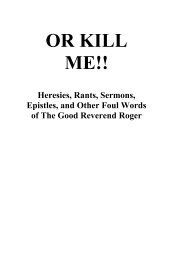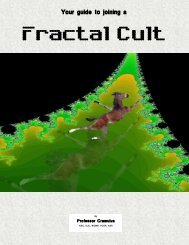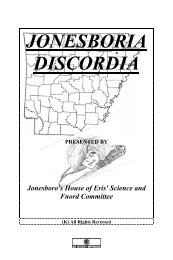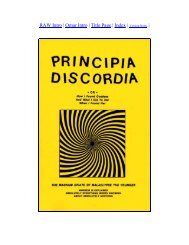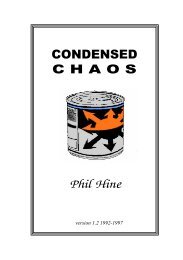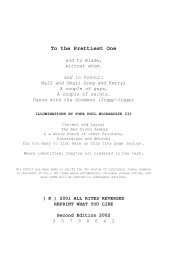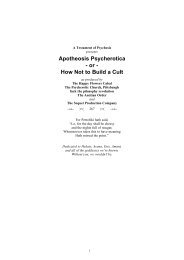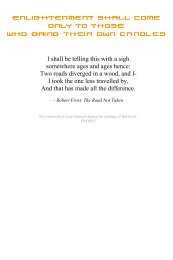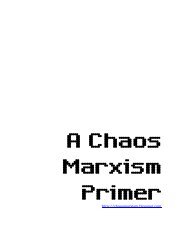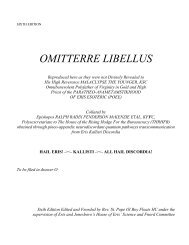Coincidance - Principia Discordia
Coincidance - Principia Discordia
Coincidance - Principia Discordia
You also want an ePaper? Increase the reach of your titles
YUMPU automatically turns print PDFs into web optimized ePapers that Google loves.
240 COINCIDANCE<br />
to time-oriented arts like music ( ), with the eventual synthesis of both<br />
into Joyce space-time prose ( ) being gently hinted.<br />
In the "Tavern" chapter, pages 309-382, the story of Buckley and the<br />
Russian General is told at length; but Joyce intercuts this with hundreds of<br />
other battles from other epochs of history, with special attention (of course)<br />
to Ciontarf and Waterloo. Curiously, there is a strong quantum mechanical<br />
theme running through this catalog of war and violence, and some of it<br />
seems very eerily prescient for a book published in 1939:<br />
On page 313, is "blown to Adams," dragging us back to Genesis again<br />
but foreshadowing nuclear war. On page 333, this comes back in the phrase<br />
"split an atam" (which again evoked Atum creating the universe by<br />
masturbating). On page 339, somebody speaks in "lipponene longuedge"<br />
which can only be Nipponese language, to say "Sehyoh narar, pokehole sann."<br />
If this is Japanese, it says "Sayanara, Pookah-sann" (Farewell, honorable<br />
Pookah) the Pookah being an ancient Celtic rabbit-god which, oddly,<br />
became Puck in Shakespeare. If one looks at the mixed Yiddish and Norse<br />
roots, of course, this sentence is also saying, "See the hunchbacked fool,"<br />
which is also appropriate to the context in which a hunch backed sailor is in<br />
conflict with a greedy tailor, and I think the s-t transformation of sailor to<br />
tailor suggests Einstein's s-t (space-time) equations. On page 349 we have<br />
"the charge of the light barricade" combining Buckley's adventures in the<br />
Crimean War (the charge of the light brigade, which involved Brown and<br />
Nolan, remember?) with Einstein's e = mc 2 and the acceleration of particles<br />
in a cyclotron. The sentence just before this on page 349 contains "guranium"<br />
which is a flower, the geranium, with a heavy dose of uranium, the trigger<br />
of the atomic bomb. All of this is explicable on the basis of Joyce's study of<br />
what physicists were talking about before he finished his book in 1939,<br />
although the Japanese reference is distinctly spooky. What the Rationalist<br />
will find most annoying, however, is the reference, within this long atomic<br />
chapter, on page 315, to "nogeysokey." I don't know what that can mean<br />
except Nagasaki. . . .<br />
Joyce's second fourfold function, X, which signifies water, fire, earth and<br />
air or Matt, Mark, Luke and John or the compass points, etc. is also an<br />
interesting isomorph with modern physics which recognizes four forces<br />
constraining all quantum systems:<br />
1. The strong force;<br />
2. The weak force;<br />
3. The electromagnetic force;<br />
4. The gravitational force.<br />
It will be profitable to consider now the rest of Joyce's system functions,<br />
since we are at this point fully aware that they are not merely "characters" in



